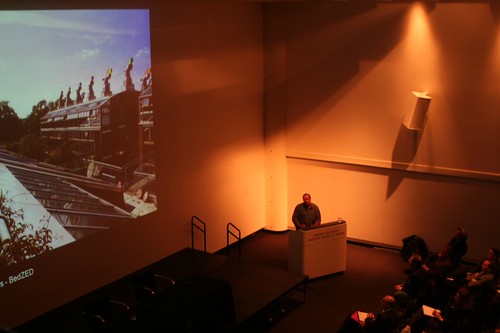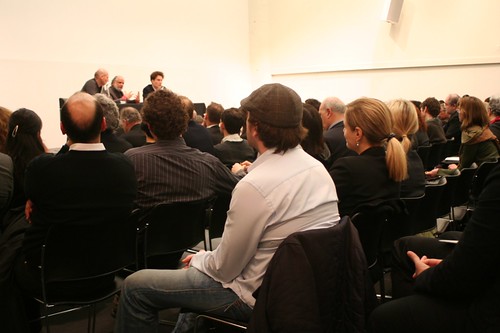Tuesday, May 12, 2009
conference summary
To talk and reflect on the full pack of presentations and debates that were collected under the term of “ecological urbanism” , means one has to summarize, conceptualize, ignore and amplify, all in an attempt to define, retroactively, an agenda. Such superficial agenda will be traced through three sections. The first would be the departure point of the conference, its keynote lecture. The second will focus on its structure and the third on its unexpected moments.
Disillusionment
The keynote lecture, aimed at providing the framework for the whole conference, brought together Rem Koolhaas and Homi Bhabha, an unlikely combination of European late avant-garde (using Michael Hays’s terms) theorist turned into world famous rationalist practitioner and a post colonialist scholar with humanist and poetic inclinations. Koolhaas, type casted as architectural prophet, was expected to provide a new direction for architecture, steering it out of the financial crisis and its own impotence in addressing real world problems. For those with such high expectations, only painful sobering awaited. Koolhaas presented a futile trajectory, looking back at well-known historical moments in architecture, he lamented these modes of knowledge that were lost soon after. His conclusions however, shed no light on the future of architecture, design, ecology, urbanism or anything in between. Bhabha’s presentation, while displaying a certain amount of charisma and vitality did no better, and the discussion of Lagos, a project that was presented more than five years ago, seemed to be superficial and anachronistic. Ecological urbanism kept on being an opaque and amorphous idea as it was before and the conference was launched under the grim shadow of failed prophecy.
Absence
On its aims, the conference sought to establish an inter-disciplinary platform of discussion about the city, nature and ecology. Hosted by the design school, its structure gave a surprisingly small portion of its share to those engaged with design. Most presentations and their following debates were made through the lens of technological aspects of development, may it be electric cars or water management systems, leaving very little room for discussion about speculation, aesthetic qualities, the role of architecture, landscape architecture and urban planning and the directions theory and practice might take. Sustainability exposed its ugly side, as an all embracing, all including term that hides behind moral justifications and as such cannot be criticized and be reflected upon. Choosing not to oppose such prevailing techniques of oppression by including designers in the programme proved to be a problem. Inter disciplinary turned out to be the weakest point of the whole event as it faced the problems of design by simply putting them out of the way.
Negation
Salvation, so it seems, came surprisingly from the other side of the Atlantic, through the presentations of Andrea Branzi and Stefano Boeri, and to a certain extent through that of Inaki Abalos. Branzi, a figure of almost mythical status in the Italian neo avant-garde, gave a presentation that was exactly the opposite of everything else in the conference: anti-rational, anti-technological and completely aesthetic. He attacked sustainability and environmentalism as creating problems rather than proposing solutions and challenged the whole notion of minimizing the human footprint on the planet as the only viable solution. In a rare moment, when challenged by Matthias Schuler and responding that beauty might be more important than survival, two world views clashed: that of the technocratic, progressive view that seeks to improve human condition through technological innovation and the opposing view of deep pessimism and negation of progress and in fact the whole tradition of rational thinking, predominant in western civilization since the enlightment. Stafano Boeri, acting as narrator for Branzi’s presentation, conceptualized three current trajectories in contemporary design and its reconciliation with nature: the first is technological mimesis, reproducing natural forms by technological means. The second is confinement which deals with dominating nature through agriculture and progressive means. The third trajectory for Boeri is autonomy, which he interprets as a challenge to the current separation between human and natural environments. Illustrating this concept with images of cities reinhabited by natural forces (animals in the streets, plants covering buildings), Boeri sought to outline an ecology in which humans exist with no superiority over other forms of living. For the first time in the conference, a new concept of operation seemed to emerge. One that is not absolute and oppressive but rather multi-faceted and complex. Suddenly designers seemed to have an important part in the definition of a shared vision about the future of humans and their role in the environment. Their disciplines may have found a new purpose beyond the notion of sustainability and the cynicism that followed. For the conference and for the idea of ecological urbanism, that was the best provocation to be hoped for.
Tuesday, April 21, 2009
timeline of sustainibility
Thursday, April 9, 2009
Klaus on GSD:ecologicalurbanism
 http://klaustoon.wordpress.com/
http://klaustoon.wordpress.com/related posts:
-Excluded Thirds
-Liveblogging Koolhaas, Bhabha, Kwinter...
Monday, April 6, 2009
Sunday, April 5, 2009
Boeri on Autonomy
REDUNDANCY!
I liked that idea a lot because redundancy is another 'humble' design tactic. It makes us accept that we cannot control it all, we can just try to mediate it. I like it because in systems that are predetermined and completely engineered there is little to no room for design. Redundancy allows design to come in and mediate indeterminacy.
In short redundancy can make sure that ecological urbanism is not about top-down efficiency.
Bike Sharing in Boston
For Harvard, Anne Lusk from the School of Public Health is working around finding funding for having bike coordinators for all of the major schools in Boston and Cambridge (MIT, Harvard, BU and Northeastern). I think one of the first projects that would be realized should this go forward would be a student bike sharing program (see the one at UNAM in Mexico City below) on Harvard's campus.

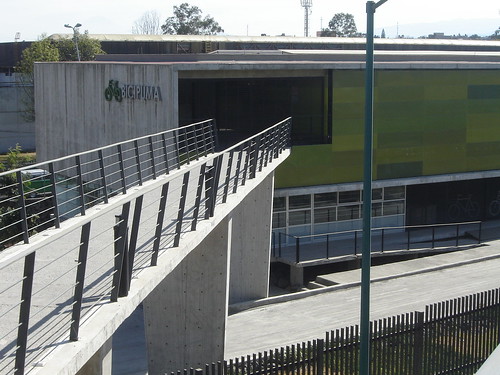
The UNAM program consists of bike cages at main buildings throughout the campus, as well as a larger facility near the university's subway station. The cages are connected by separated bike paths, including bridges over major streets for bicyclists. As a student, you just walk up, swipe your student ID, take a bike, and drop it at any other cage. A similar program at Harvard is certainly within our reach.


For more info on biking in Boston, check out the LivableStreets Alliance (where I am on the board), Bikes not Bombs and MassBike.
On Informality - A Response by Guest Blogger Kazys Varnelis
http://varnelis.net/blog/on_informality
Kazys Varnelis is the Director of the Network Architecture Lab at the Columbia University Graduate School of Architecture, Planning, and Preservation. With Robert Sumrell, he runs the non-profit architectural collective AUDC.
EXCERPT:
Quilian Riano asked me to participate in the blogging revolving around the GSD event on Ecological Urbanism. Although Quilian is live blogging the event, like the live blogging for Postopolis going on simultaneously, I think it makes much more sense to the participants than to those of us listening in at a remove, observing highly compressed fragments of the conversation.
Even if I take my knowledge of the event second-hand, I thought I'd offer a response, prematurely broaching a topic that I've been engulfed in for the first part of this year. I'll begin with the event's statement of purpose, the core of which reads as follows:
The conference is organized around the premise that an ecological approach is urgently needed both as a remedial device for the contemporary city and an organizing principle for new cities. An ecological urbanism represents a more holistic approach than is generally the case with urbanism today, demanding alternative ways of thinking and designing.
In ecological urbanism, the informal seems to crop up repeatedly. Instead of "green architecture" and its outworn advocacy of LEED to design our way out of a global ecological crisis, the conference proposes an urbanism produced bottom-up, in a natural way, like an ecosystem.
Sanford Kwinter's keen observation that New York's culture has come to a crashing halt under the weight of capital, overdevelopment, and hipsterdom serves as a set-up to ecological urbanism. Instead of a vital urban realm, we have a stuffed animal (to use a phrase Peter Eisenman once applied to European cities…and let's just be clear that today cities anywhere in the developing world don't fare any better than Manhattan does). In the face of this collapsing formal urbanism, then, Quilian observes, informality is thriving:
[There is an]… anxiety around the failure of the formal structures in the West. Populations are dropping, immigration increasing, manufacturing and economic strength shifting to other nations. Western nations are facing a changing culture at home and a shifting power structure abroad. As formal structures fail informal systems take over.
We've heard this before, in the recent fascination with favelas and their capacity for self-organization. When Rem Koolhaas spoke he brought out Lagos, his exemplar of such a self-organizing city, a nightmare condition that nevertheless he feels somehow works. In doing so, he replays Venturi, Scott Brown, and Izenour's Learning from Las Vegas as well as Reyner Banham's Los Angeles: The Architecture of Four Ecologies, but in going to Africa, Koolhaas is not so much flipping the valence on a "low," pop phenomena as replaying the modernist obsession with the primitive (to be fair, on the East, the West is often seen in terms of the primitive). In the darkest places, the modern obsession with the primitive suggested, we would identify the next modernity. So Koolhaas hopes to do at Lagos...
READ THE FULL ESSAY ON VARNELIS' BLOGAndrea Branzi Videos
The following are my favorites:
-No-Stop-City
-Concorso Internazionale di idee, bandito dalla New York Art Society, per la sistemazione del Waterfront Ovest di Manhattan a New York (2° premio)
-Agronica
-Vertical Home
I had not seen the videos before Branzi presented them last night. The music, editing and collage gave me new insights into his work. I now see clearly the connections to minimalist music, biological processes, and he even gave hints at these being set within real landscapes.
The hints of real landscapes bring up some questions I have always had for Branzi:
First, what is your site, your landscape. From No-Stop City to, my personal favorite, Agronica the site seems like an abstraction and a real place at the same time. In Agronica the video is edited with images of a real landscape organized in perfect rows. Where is that? Is that 'the site'? Does it matter?
Second, why has the 'language' developed in No-Stop City never been deployed in a mountanous site? The language looks like it wants to be universal, yet as deployed right now it would work in very few places in the world. Does it matter? Would it be a fruitful exercise?
Third, the projects with their extreme horizontality seem very American. More specifically, mid-western. Agronica remind me of the agro-industrial fields from Missouri to Iowa. Is that intentional?
 Achizoom - No-Stop City, 1968
Achizoom - No-Stop City, 1968
defining moment
++++++++++++++++++++++++++++++++++++++++++
to be continued
Saturday, April 4, 2009
Mike Davis on Koolhaas' Lagos - By Guest Blogger Orhan Ayyuce
Orhan sent us a section of an interview he held with Mike Davis:
Orhan Ayyuce:
What do you think of the current interest in slum communities. It is almost unfortunately 'interesting' to talk about slums and their informality. May I say that the trend started around the time you published Planet of Slums?”
Mike Davis:
You know, in architecture school most people talk about icons and counter icons, rather than try to understand the larger social networks, hierarchies, and conditions that produce particular types of urbanisms. That is taken to its highest level of trendiness by Rem Koolhaas. His stuff on Lagos is crazy... In my mind it is a sleazy apology for social evil.
If you want to see human self organization at work, go to Lagos, but face the poverty and oppression by the military regime ... Maybe he should talk to my friend *Chris Abani about that stuff... Chris would laugh at his hyperbolic exercise...
*http://www.chrisabani.com/Abani_Fiction/Graceland.htm
candid photos
velib!


A question from the audience during the 'mobility, infrastructure, and society' panel brought up the bicycle. The panelists hadn't really mentioned its role in mobility and infrastructure. The Velib program in Paris is a great example of how the bicycle can become an integral part of urban transportation infrastructure. All cities should have this sort of program and at this scale. It's brilliant. 24 hours a day 7 days a week you have access to a free bicycle, available at stations spaced approximately every 300 meters throughout the city.
Architecture Imagined as Ecological - by Guest Blogger Javier Arbona
Javier Arbona is a University of California, Berkeley PhD candidate in geography with a background in architecture and urbanism.
EXCERPT:
 Architecture imagined as ecological
Architecture imagined as ecologicalThe all-encompassing discourse of sustainability is tangled up with global geopolitics at every turn, but that discourse hides its tail. What’s worse is that “sustainable architecture” can be the proverbial “greenwash,” as I think has become more than evident. We would only have to pass a roll-call of all the eco-resorts done in years of economic fluidity. Thinking about a sustainable practice is (still) supposed to arouse in us a moral instinct of how to satisfy our needs without “compromising the needs of future generations”. The small house movement serves as a good example of an architecture informed by notions of what is said to be ‘basic’.
Our “needs,” however, are a mirage. We know that they are essentially malleable. They’re subject to crass marketing manipulation. They evolve through the sieves of culture and desire. They’re hard to pin down and it’s no accident that capitalism pulls the rug from underneath us as soon as we try. Besides, unless the global economic crisis ends up destroying capitalism, we satisfy our so-called needs through an increasingly global economy, despite the localist and nationalist fantasies some may have. Even if we didn’t have capitalism, we’d still have trade, and subscribers to notions of Malthusian natural limits fail to adequately take this into account. Sometimes the sustainability talk sounds to me even xenophobic in its suggestions that a certain number of citizens will have a right to the city (blurring further the notion of what is natural: Numerical limits? Naturalization, as in citizenship?)
The ideologues of sustainability might deny that it is an issue of power and not morals, but it is. It has to do with who determines how much is a reasonable need for some and not others, both at a local and global level. By the way, I’m sorry for even using these terms like “local” and “global” because they pertain to imprecise scales, especially when ecological processes are involved. But none of this has slowed down the field of architecture. As often times is clear in the works of architects like Michael Sorkin and other adherents to the “ecological footprint,” design indexes how much nature is judged to be fair and balanced according to some metric of consumption.
GO TO JAVIER'S BLOG TO READ THE ENTIRE ESSAYruralization of urbanism?
I am skeptical. McHargian environmentalism, while still alive and relevant is not the only strain of environmentalism. Those that emphasize environmental health and or environmental justice tend to be more encompassing and less critical of the fundamental value of the city. While Sustainable South Bronx and Youth Ministries for Peace and Justice might be advocating for the 'greening' of the Bronx, I don't think they fully embrace the McHargian disdain for the city. These environmentalists love their neighborhoods and want to make them healthy and sustainable. They understand that their neighborhoods cannot promote public health or support healthy economies without being ecologically sustainable. They are making the Bronx more 'ecological' and the suburbs have nothing to do with it.
Why Informal?
I want to share my first impressions as I try to find reasons for the focus on the informal in a conference about ecology.
1-A WAY IN
Designers seem to have a hard time getting into ecology as way of working. The informal allows us a way into the discussion. The word 'informal' seems to stand in for the larger economic, political, environmental, and social contexts that designers cannot fully account for and thus control. This condition then produces many products including built environments.
Using the shorthand 'informal' gives us a way into the problem. We can strategically choose some of the systems to act upon and be flexible to account for the rest. This is what I think Koolhaas means when he talks about the formal and informal growing together.
Koolhas says that he learned that lesson after going to Lagos. However, his design for La Villette was already trying to design such a condition. The design provides the minimum infrastructure required while allowing major sections of the park to change as economy, community, and political-will allow.
 framing informality, OMA's La Villette
framing informality, OMA's La Villette2- WESTERN ANXIETY
Kwinter officially declared NYC dead last night. He says that it is because it is a boring place now. Such a strong statement has to have a cause larger than a few porn shops turning into Disney stores.
Maybe the statement has to more to do with anxiety around the failure of the formal structures in the West. Populations are dropping, immigration increasing, manufacturing and economic strength shifting to other nations. Western nations are facing a changing culture at home and a shifting power structure abroad. As formal structures fail informal systems take over (American Tent Cities in NYT).
This anxiety was partially at display last night. Koolhaas, Bhabha, and Kwinter talked about Lagos and Mumbai with excitement and interest, about New York and Europe with a measure of pessimism. Studies in the informal are a way to then anticipate and mediate changes in Western cities as well as in developing nations.
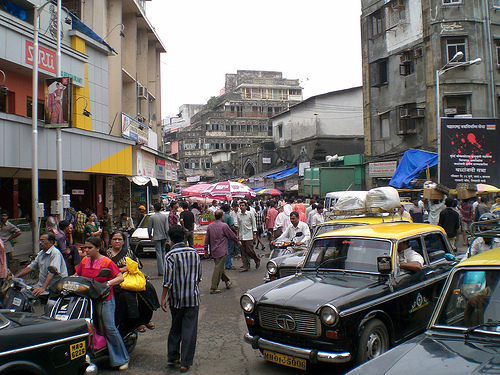 Mumbai Street Life
Mumbai Street Life New York as Mall
New York as Mall3- PREEMPTING TOP-DOWN ECOLOGICAL SOLUTIONS
I wrote earlier about Slave City and its dystopian look at the future of Ecological Cities. It shows what can happen when the need for efficiency becomes the primary concern of the formal urban, architectural, and social structures.
I think that all the talk about informality is trying to preempt such a scenario. It is partly about the humility by designers that Koolhaas and Kwinter called for last night. They are telling designers that they will really never know everything about a condition, there is no reason design as if you do... there are intelligences out there as great as your own.
 Slave City - Model Work Sleep Unit
Slave City - Model Work Sleep Unit...and BEES
Homer's Second Appearance at the Conference
– Harvard President Drew Gilpen Faust
"Yes… Crisatunity"
– Homer Simpson
Farming the horizontal plane
What is the role that designers can play in this bottom up movement? As my interviews with Deborah Greig and Owen Taylor - two urban farmers, educators, and local food advocates - about the Work AC installation at PS1 illustrate, there is an wary enthusiasm amongst the local food community around the designer input into urban agriculture.
This morning Nina-Marie Lister outlined for us some opportunities of designers and planners. We can map interstitial spaces in cities and facilitate growth of these community based, bottom-up systems. But is that all? Can't we do more?
As the sole planner writing about the conference, I have to admit that I was a little concerned about having an architect and a literary critic delivering the keynote at conference that is specifically urban. For someone who studies the city full time, architect’s presentations on urbanism can, at times, seem woefully naïve. Setting aside the (admitted) irony of Rem Koolhaas declaring an end to starcatecture, I was extremely impressed by the nuance and depth of his presentation, as well as the ease of his movement between the architectural and urban scales with clarity.
I especially enjoyed the short look at the California Academy of Sciences building as well as the characterization that we have too often “equated literal greening” with ecological sustainability. I recently saw a project that included significant introduction of northern American foliage to a park in Albuquerque with the goal of “greening” the city. Yes, perhaps the color green will abound, but only at a huge environmental cost to create the necessary ecosystem for it to exist in that climate. This, as Koolhaas said, is the “artificiality to which we’ve become accustomed.”
Excluded Thirds
Rem Koolhaas thankfully presented a resolutely hybrid interpretation of ecology. His argument incorporated a narrative of "reasonable progress" and a narrative of "disasters," each of which contained a social/cultural dimension. Rem's excluded third was the pairing of knowledge with ambition: he lamented the "devastating effect on knowledge" of ways of working with informal architecture that occurred during the growth of the market economy post-1970. The ways of quantifying ecology developed during the 60s were not advanced beyond a touchingly naive stage. The ambition to carry out large scale projects with serious ecological impact - exemplified by Buckminster Fuller - imploded during the same period.
Both Sanford and Rem argued in a way that carved out a niche for themselves, one as a practitioner of the formal where it intersects with the informal, the other as a theorist working on the specific social and cultural dimensions of the science of ecology.
Homi Bhabha spoke with greater disinterest and less directness; I will need to look over his argument once again before I begin to understand it.
Follow the Conference Live...
good quotes from the day
'Sustainable urbanism should not mean green cities for wealthy white people'
Lizabeth Cohen
'Good cities are like French cheeses. The worse they smell the better they are.'
Homi Bhabha
I thought it was interesting how in the opening panel of this weekend's conference the terms sustainable, green and ecology were used so interchangeably. Different panelists latched on to different terms for their own purposes, and in this smashingly interdisciplinary panel there were a multitude of agendas and positions. Are these terms identical in meaning? If not, what is the difference between them? Is one more inclusive than another? And is this disparate conversation useful for defining a clear agenda for a new sort of urbanism? Or is it impossible to have a single agenda for something as abstractly defined as ecological urbanism?
As for the French cheese comment, it certainly elicits visceral reaction, though it strikes me as a rather romantic notion of the city. Smelly cities may be more complex and implicitly more exciting, than the sterile or 'dead' city (Stanford Kwinter just killed New York tonight, by the way), but isn't this just the sort of excitement that lends itself to a touristic voyeurism and encourages a view of the city as place exclusively of voyeurism and vice? Maybe New York was more 'alive' in the 70s than it is today, and we can have a nostalgia about that time, with some very good reason, but I must say that it the quality of life can be much higher in a city with a more refreshing and neutral smell. Personally, my parents (longstanding NYC residents) are much happier that the neighborhood whorehouse has been converted to condos and that the subways are safe at all hours. Maybe the city is more sterile, but we shouldn't forget that sterility too has its charms.
All said, I must admit that I found the first panel far more exciting than the keynote. The diversity of viewpoints and the dialogue between them was far more interesting to me than the rhetoric that followed.
Friday, April 3, 2009
Utopia and Nature in Planning
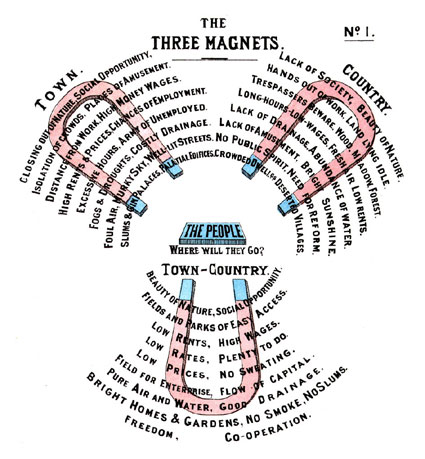
Garden City...
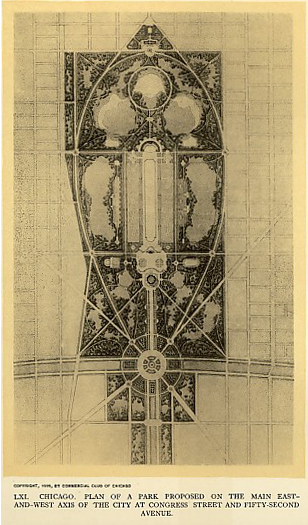
City Beautiful...
In fact, most of the Utopian movements in planning had at least something to do with the relationship between the city and the environment. I'm interested to see if Ecological Urbanism is able to move this connection further or if it simple reiterates past ideas.
Thursday, April 2, 2009
landscape provocations
The conversation between Gary Hildebrand and Chris Reed touched on the economic value of ecology in the urban environment - addressing the ever increasing value of defining ecosystem services and the potential for urban ecology to provide an infrastructural role in the city.
As Gary hinted at this afternoon, a street tree is not just a tree, but a critical element of our city, cleaning air, sequestering carbon, diminishing the urban heat island effect, and providing countless other environmental and economic benefits to the city. Indeed, a city of trees therefore would be a more livable city - ecological or otherwise. Chris spoke of the potential of landscape to function as a water filtration mechanism, and to be both more cost effective and attractive than traditional systems of civil engineering. In the examples that they raised landscape functions as infrastructure - an idea which fits nicely into the more abstract ecological urbanism. A landscape always contains ecology. So it would follow that the more landscape you have the more ecology. Landscape infrastructure should therefore be a fundamental component of the Ecological City.
The thing that I like about the exhibit and what I hope to discover through the conference, is the notion that ecological urbanism includes not only this infrastructural landscape approach, but that is goes beyond the landscape. It more pluralistic and encompassing of multiple disciplines - it says that it isn't just us landscape folks who can green the city and you don't have to portend to be a landscape designer to be a part of this movement. What I can ascertain from the exhibit is that ecological urbanism is design which impacts the city at all its scales, and attempts to do so in a way that learns from nature and/or is harmonious with its principals. That's exciting.
What does that mean?
Is it what Roman Polanski said about Chinatown?
Is that why, as Ilana pointed out, a chair and a coffin belong in an exhibit on Ecological Urbanism?
When Ecological Optimism Gives Way to Fear
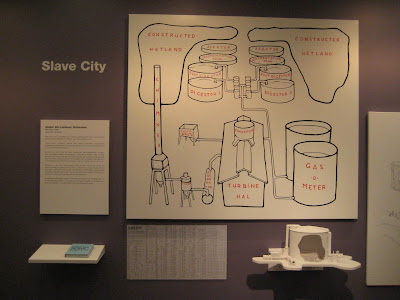 Slave City in Ecological Urbanism Conference, GSD - by author
Slave City in Ecological Urbanism Conference, GSD - by authorAtelier Van Lieshout, takes this premise and gives us Slave City. What at first may have been a beneficial system takes on a sinister tone, utopia giving way to dystopia.
I was amazed to see this project in the exhibit. It is there as a pre-indictment of designs that may have the impulse to go too far. Though we know that no one would intentionally go this far dystopia comes in small steps.
 Model Work Sleep Unit with Puppets, 2006; steel, wood and clay; 70 x 17 x 25 cm - dezeen.com
Model Work Sleep Unit with Puppets, 2006; steel, wood and clay; 70 x 17 x 25 cm - dezeen.comThat is why I was even more amazed to see the work of Senseable City lab just in front of Slave City. Don't get me wrong, I like their work but have to admit that I am afraid of it. I am not sure, for example, if I am comfortable with a government office having the technology to track my bike or cell phone. Today's cool tool of urban study is tomorrow's way to track dissent.
 From SenseableCity Real Time Rome : Detail from Software 2. The yellow lines represent buses in real time and the red corresponds to density of people. Sep 2006
From SenseableCity Real Time Rome : Detail from Software 2. The yellow lines represent buses in real time and the red corresponds to density of people. Sep 2006As the discussion of ecological design (whatever that turns out to mean) continues it seems that issues of privacy, appropriate use of technology, and even freedom will have to join the discussion of efficiency. Furthermore, ecological design should include a larger social agenda that does not allow it to be co-opted as a mere marketing and political tool. Or as the trays ZINE editorial put it, Ecology, INC.
Wednesday, April 1, 2009
EcologicalUrbanism Student Installation
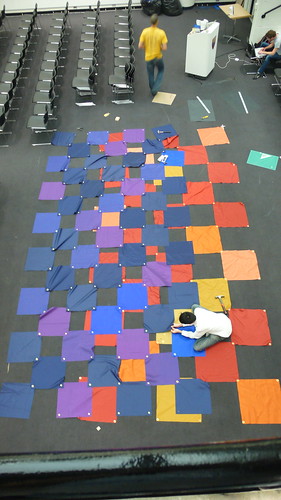

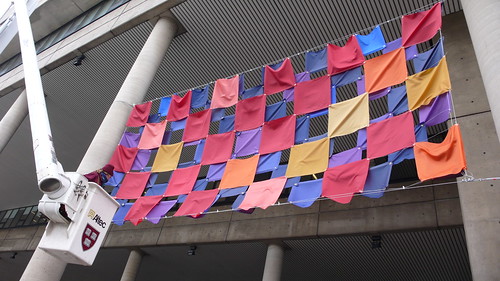
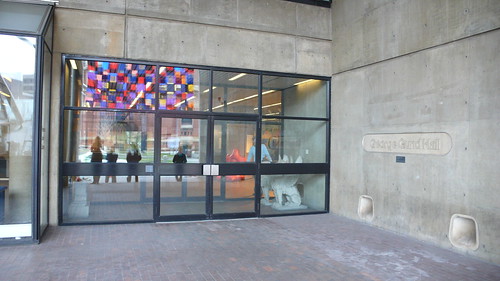
I'll leave you with a little Inflatables! juggling in Piper:
Hope you are ok Dan!
Before Conference II
The exhibition consists of a collection of artifacts that "do something". Generally, they are either prototypes or describe an idea which can suggest a prototype. The exhibition resembles a science fair and aims at creating a notion of optimism towards a certain future by implying that salvation is possible through innovation.
---------------------------------------------

The difference between science and a science fair is that the latter exhibits singularities lacking in context. Science, on the other hand, tends to associate different ideas within fields. In science, the products are the manifestation of a paradigm, and are no more than a good editing job. A good product jilts the paradigm letting it subside into a new state of stability by reinterpreting concepts. In other words, it's not what the product does, it's how it reinterprets the contingencies.
The artifacts exhibited are not attempting to suggest a potential for changing the urban paradigm. An example of public concerns that initiated a change in the urban condition can be found throughout the entire 20th century: fire protection codes, sanitation, decent housing, transportation reforms, accessibility and others, have dramatically changed how we construct and use the city.
---------------------------------------------
Placing innovation in context changes existing relationship and should be addressed mainly to redefine urban concepts of transportation, public space, commerce etc.
In ecology, a Type is a manifestation of the underling forces; displaying the isolated Type undermines its ecologial role within the urban habitat.
comment II
comment I
trays ZINE - ECOURBANISM V OBLIVION
DOWNLOAD THE FULL PDF
Published 03/31/09
Edited by James Moore + Zakcq Lockrem
Designed by Cara Liberatore + Shelby Doyle
CONTENTS
Editors - On Ecological Urbanism
Abdulla Darrat - On Ecozoning
Anonymous - On Wildlife in Cambridge
ae.i.ou - On Puerto Rico
Andrew Tenbrink - On Landfarming
Quilian Riano - On Lagos
Matthew Waxman - On Total Context
Erik Prince - On Mat Ecologies
Tuesday, March 31, 2009
two questions:
and what is Urbanism, anyways? I thought that urbanism implied an urban, ie large, scale. That doesn't implicitly mean a giant intervention into the city - tactical insertions into the city are urbanism as well - but it does imply an approach that examines design at a city scale.
The exhibit is provocative in that it suggests that the design of a chair is urbanism. The design of a coffin is as well. Landscape urbanism doesn't address chairs and coffins. Is that the difference?
Student Exhibit - VEGETAL CITY: dreaming the Green Utopia
VEGETAL CITY: dreaming the Green Utopia
A vision of the future biocity by Luc Schuiten

“But I also start here…: we are now beyond utopia; beyond Le Corbusier's utopia, to be sure, but beyond the very idea of utopia itself. We can no longer share the fundamental assumption that lies behind this image: that it is both possible and desirable to completely rebuild our cities and our societies according to some new and better model… “If we are "beyond utopia”, we have also reached the end of cities. I do not mean here that all cities are now fated to decay. I mean that we have reached the end of a whole era in history where the dynamism of civilizations was tied up with their capacity to focus their energies in great cities.”
-Robert Fishman
“The cities should be built in the countryside. The air is purer there.”
-Alphonse Allais.


The beginning of the millennium has been characterized by a growing awareness of the crucial role of the climatic changes on our future. UNESCO, Giec, the international summits of Rio, Johannesburg and Bali speak of the increasing need for a radical change in the behavior of our society. Nature is no longer considered as an inexhaustible manna from heaven but rather as an inevitable ally with whom we need to cooperate in the edification of a long lasting society.
In this context, the purpose of the esxhibition "Vegetal City" is to suggest another way towards a long lasting and bright future for the planet that may be possible through non conventional processes. The life to come has to be considered an attempt of reconciliation with nature that enables us to live together in a balanced harmony. The selection of works featured here is conceived as a progression in time and space, through Luc Schuiten's eye, focusing on Nature's presence as a model for a new way of building. The work of the iconoclastic Belgian architect Luc Schuiten (Brussels, 1944) brings in a visionary glance that parallels a certain secularization of the “green” approach to the city. Educated as an architect in the 60s, Schuiten has developed, in the last 30 years, a work that ranges from the hyperrealistic approach to architecture given by autoconstruction and the pursue of energetic efficiency, to the utopian urbanism of megastructures, from the field of comics and science fiction to the construction of ecological buildings, and from a démodé revision of Art Nouveau to the most recent theories of “biomimicry”.
Schuiten understands architecture as an organism, a living system where the logics of the element (the cell) are translated, in a net of growing complexity, to the design of the house, and of the very city. Starting with his early concept of the habitarbre (“inhabitree”), he has explored for over thirty years new ways to reformulate the relationship between man and dwelling, building and environment, city and landscape. Through his concept of archiborescence, his early projects for maisons biosolaires (bio-solar houses) and habitarbres (inhabitrees) led him to the design of the “archiborescent cities”, utopian projects where the vegetalistic style of his houses evolved into a reflection on the possibilities of the fusion between city and natural ecosystems.
With Archiborescence, which brings together architecture and arborescence as an echo of Paolo Soleri’s Arcology (architecture + ecology), Luc Schuiten shows a glimpse of what a different understanding of the interaction between technology and nature could offer us. As a counterpart to our increasingly digital reality, Archiborescence suggests the use of biotechnology as a tool to actually rebuild the link between man and nature through construction systems that evolve directly from nature. Far from the dark images of the cities of the future Luc Schuiten envisions a harmonious future gestated on a new use of the ecosystems where cities become living entities. In a time when utopia seems to have been discarded as a tool to rethink our way of building the future, those visions offer other models for the organization, form, and the very materiality of the cities that introduce the utopian twist of the 1960s in the ecologically concerned panorama of the new millennium.
-Luis Miguel Lus Arana (exhibition curator)




Luc Schuiten (Brussels, 1944) graduated from l'Institut Supérieur d'Architecture Victor Horta in 1967. In the late seventies, after working with Willy Vandermeeren and Lucien Kroll (1968-69), and spending one year constructing villages in the desert of Morocco, he started researching on the possibilities of the integration of architecture/city and nature. In 1978 he started his series of Maisons Biosolaires with his own house and atelier Maison "Oréjona" (Overijse, Brussels), which was followed by the equally autoconstructed pavillon à 7 côtés (1982), the project for the Maison Biosolaire de Ville (1979), the « Maison Camerman » (Rosières, 1981) and the Maison Dassonville-Monette (1990). Throughot these projects he developed a personal research on the stylistic possibilities of an Art Nouveau that evolved from nature. Parallel to these bioclimatic projects, the concept of «habitarbre» (inhabitree), first developed in the non-built project for the «Maison Cristal» in 1977, has been key in his conceptualization of archiborescence, an approach to architecture that uses as its main elements of construction living organisms, especially vegetal. According to the principles of archiborescence, Luc Schuiten has developed a substantial amount of utopian projects for archiborescent cities, such as “la cite des habitarbres”, “les cites des toits jardins”, “la cité des vagues”, the lotus city and others, where he uses at an urban scale Janine Benyus’s concept of biomimétisme. Along with these prospective works, since 1995, the Atelier Luc Schuiten has developed a series of projects for “vertical gardens” that introduce vegetation in the residual spaces of Brussels, as well as other projects for “green” infrastructures such as the toll gate for the Autoroute A-29 (1996). He has published three books on this topic: Archiborescence (2006), Habitarbre (2007) and Vegetal City (2009). Luc Schuiten’s unorthodox approach to architecture also permeates his works in vindicative, ecology related, art. Along with Raphaël Opstaële, Pierre Gonay, Claire Lamy, Johan Opstaële and Barbara Haln, he founded the group Mass and Individual Moving that erected the polemical Radioactive Monuments in Brussels, Hasselt, Utrecht, Amsterdam and Middelburg in 1976. Along with his brother, comics artist François Shuiten, he created the series Les Terres Creuses in 1979, featuring a variant of the same utopian and environmentally conscious themes, and working as a showcase for some of his architectural designs. Among other prizes, Luc Schuiten has received the Prix Robert Maskens for the Maison "Orejona" (1978); the first prize in the competition "Pour un habitat de qualité" organised by the magazine Architecture Belgium with une maison bioclimatique de ville (1979). His project for the housing building "Oxygène", his Maison Camerman (Rosières, 1981) and the Maison Dassonville-Monette (1991) were also prized in competitions organized by the Ministère de la Région Wallonne. Recent samples of Luc Schuiten’s work have been featured in the exhibition “Archiborescence: Architectures Organiques et Visions Utopiques” (Yverdon-les-Bains (Switzerland, October 29, 2006 – March 11, 2007), “Utopia: De L'atlantide Aux Cites Du Futur” (Mons, April 20 – October 28, 2007), and in the Congress “Utopiales: Climats” (Nantes, October 31 – November 4, 2007)
VEGETAL CITY: dreaming the Green Utopia
A vision of the future biocity by Luc Schuiten
Harvard Graduate School of Design, March 30 – April 4, 2009
Coordination: Aude-Line Duliere / Luis Miguel Lus Arana
Design and additional texts: Luis Miguel Lus Arana
Original Vegetal City Exhibition Concept by Luc Schuiten
All images © 2009 Luc Schuiten. Special thanks to Atelier d’Architecture Schuiten, Éditions Mardaga, Ana Flor Ortiz, Emilio Ontiveros, Rodia Valladares and Juan Mínguez.
Sponsors:
Harvard Latin GSD
Harvard European Club
Contact: Luis Miguel (Koldo) Lus Arana: lusarana@gsd.harvard.edu / koldolus@gmail.com

Main Gallery - Ecological Urbanism Exhibit
But I had to comment on this:
 I can bet this is the first coffin ever exhibited at Harvard University's GSD. This coffin seems to somehow capture the spirit of this whole thing better than any of the other work.
I can bet this is the first coffin ever exhibited at Harvard University's GSD. This coffin seems to somehow capture the spirit of this whole thing better than any of the other work.It takes a program and form we all think we know (and truly do not even want to think about) and does something new with it. The material is recycled and will, appropriately to its program, biodegrade in the soil and the new shape makes it so that less of that material is used. The scope is humble but it could have a big impact.
In this case it is definitely worth looking at the necropolis for inspiration.
green architecture
- a quote from a discussion in room 518
Building for Disaster
trays editor Aron Chang has just posted a series of essays and interviews exploring re-building in the post-katrina gulf coast around a case study.
-Rebuilding Biloxi's Ohr-O'Keefe Museum of Art
This is a brief description of the effects of Katrina upon the Ohr-O’Keefe Museum, which serve as an introduction to the articles that follow.
-Katrina and the Ohr-O'Keefe Museum of Art, Q&A with Marjie Gowdy
Marjie Gowdy was the executive director of the Ohr O’Keefe museum at the time of Katrina and in the years immediately following the storm.
-Katrina and the Ohr-O'Keefe Museum of Art, Q&A with Joey Crain
Joey Crain is the architect of record for the Ohr-O'Keefe Museum at Guild Hardy Architects.
-Katrina and the Ohr-O'Keefe Museum of Art, Q&A with Brian Zamora
Brian Zamora is the Project Designer for the Ohr O’Keefe Museum at Gehry Partners.

Monday, March 30, 2009
According to Ecology, Fourth Edition, by Robert E. Ricklefs and Gary L. Miller, "Ecology is the study of the natural environment and of the relations of organisms to one another and to their surroundings." It's a pretty standard text, so I think the definition is a worthwhile one.
Based upon this definition, is ecological urbanism an urbanism in which the natural environment is emphasized and relationships between organisms and their surroundings is valued? Relationships and nature. Sounds pretty vague to me. Each of those words is loaded with layers of meaning and is tremendously problematic, perhaps to the point of meaninglessness.
The appeal of looking to the sciences for new methods of understanding urbanism is appealing, but is such an ill defined science such as ecology the best one to pick? Is it useful? Is it new? To be determined this weekend...In the meantime I wonder about other what other forms of urbanism might be worth pondering - geological urbanism? hydrological urbanism? neurological urbanism? Trendsetters, look out for organic chemical urbanism!
Sunday, March 29, 2009
More platforms
http://www.flickr.com/groups/1068168@N21/
to follow our twitter updates:
http://twitter.com/GSDecourbanism
and to join us in facebook:
http://www.facebook.com/group.php?gid=91536756392&ref=ts
just posted this in my archinect blog
Saturday, March 28, 2009
Sloterdijk on the "world house"
"We are simply not capable of continuing the old cosmology of ancient Europe that rested on equating the house and home with the world. Classical metaphysics is a phantasm on an implicit motif that was highlighted in only a few places, e.g., by Hegel and Heidegger, namely that the world must itself be construed as having the character of a house and that people in Western culture should be grasped not only as mortals, but also as house residents. Their relation to the world as a whole is that of inhabitants in a crowded building called cosmos. So the questions are, 'Why should modern thought bid goodbye to this equation of world and house? Why do we need a new image in order to designate how modern man lives in social and architectural containers? Why do I propose the concept of foams?'Sloterdijk would consider the term ecology outmoded, referring to a global "world house" that only makes sense in a classical metaphysics. Ecological urbanism may construe urbanism as part of a system out of scale with the types of interventions architects/urbanists are in a position to make. This may explain the unusual presence of public officials at the conference...
"The simple answer is: Because since the Enlightenment we have no longer needed a universal house in order to find the world a place worthy of inhabiting. What suffices is a unité d’habitation, a stackable number of inhabitable cells. Through the motif of the inhabited cell I can uphold the spherical imperative that applies to all forms of human life but does not presuppose cosmic totalization. The stacking of cells in an apartment block, for instance, no longer generates the classical world/house entity, but an architectural foam, a multi-chambered system made of relatively stabilized personal worlds."
What is Ecological Urbanism...
Perhaps, though, it is not a problem with the conference or its exhibit, but rather it is a problem with its name. It is not trying to find a singular definition or vision for ecological urbanism but rather many of them. To give the work and speakers room to maneuver the conference should really be thought as 'Ecological Urbanism(S)'. The conference will really try to create a pluralistic and complex ecosystem of ideas.
Instead we are left with the question: what is ecological urbanism to you? You will more likely than not find work and speakers that support your position. However, while you respond this question it is comforting to know that the term itself is inclusive and will include other ways of thinking.
Personally I find the idea of ecological urbanism most helpful when it helps create a design methodology rather than strict rules. Looking for such a methodlogy it is helpful to look at Charles Waldheim's Landscape Urbanism. In the book Waldheim begins to describe a methodology of design that takes ecology as a medium of constant change. Design is then left to frame and guide that change. I will be in the look out for practitioners that use this design method.
Furthermore, I am interested in seeing if Koolhaas brings up his study of Lagos. I have written about this study, and specifically the Makoko Slum, in my thesis blog. I wrote an extended look at the Makoko for the trays eco-zine that will come out next week.
quote from my blog:
"Koolhaas also mentions the informal community of Makoko in Lagos as a possible prototype for growth there and in other cities. He is interested by the way the community has grown around the bay to saw, store, and ship lumber. In Makoko we can see an intersection of ecological conditions, commerce, infrastructure, and community. This slum and Koolhaas' reading remind me of the diagram (above) I produced for the NICAestudio. This diagram was meant to say that the new housing in informal settings needed to be embedded with commercial and social activities and then critically set within the landscape. Furthermore, this reading also signifies an evolution of Koolhaas' urban/ecological views from La Villete..."





